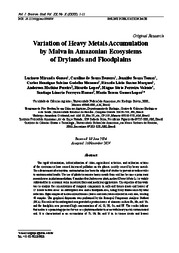Variation of heavy metals accumulation by malva in Amazonian ecosystems of drylands and floodplains.
Variation of heavy metals accumulation by malva in Amazonian ecosystems of drylands and floodplains.
Author(s): GOMES, L. M.; BEZERRA, C. de S.; TOMAZ, J. S.; MENESES, C. H. S. G.; MARQUES, R. L. S.; PEREIRA, A. M.; LOPES, R.; VALENTE, M. S. F.; FERREYRA RAMOS, S. L.; LOPES, M. T. G.
Summary: The rapid urbanization, industrialization of cities, agricultural activities, and utilitarian actions of the environment have caused increased pollution on the planet, mainly caused by heavy metals. The advancement of ecosystem contamination has been the subject of studies to prevent or reduce risks to environmental health. The use of plants to remove heavy metals from soil has become a prominent research area in phytoremediation. Considered an herbaceous plant, malva (Urena lobata L.) is widely cultivated for its economic value in natural fibers and medicinal applications. The objective of this work was to analyze the concentrations of inorganic components in soils and tissues (roots and leaves) of U. lobata in two areas: an anthropized area and a floodplain area, using X-ray fluorescence by total reflection.
Publication year: 2024
Types of publication: Journal article
Unit: Embrapa Western Amazon
Observation
Some of Embrapa's publications are published as ePub files. To read them, use or download one of the following free software options to your computer or mobile device. Android: Google Play Books; IOS: iBooks; Windows and Linux: Calibre.
Access other publications
Access the Agricultural Research Database (BDPA) to consult Embrapa's full library collection and records.
Visit Embrapa Bookstore to purchase books and other publications sold by Embrapa.

